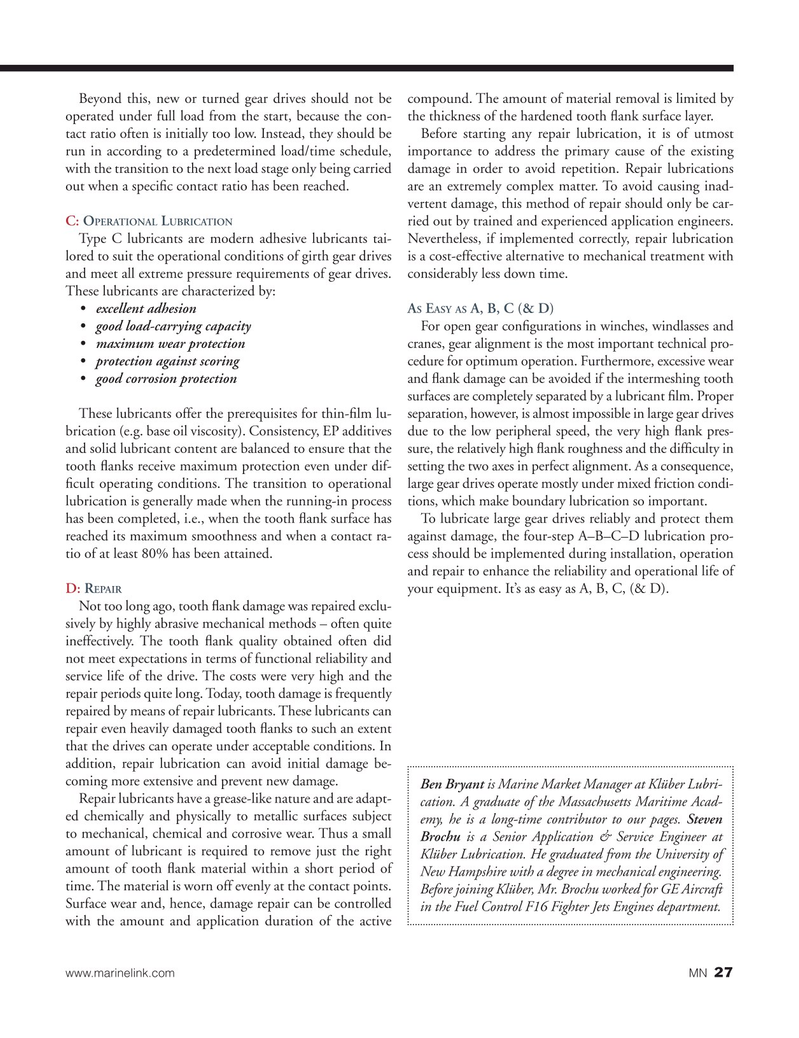
Page 27: of Marine News Magazine (February 2018)
Dredging & Marine Construction
Read this page in Pdf, Flash or Html5 edition of February 2018 Marine News Magazine
Beyond this, new or turned gear drives should not be compound. The amount of material removal is limited by operated under full load from the start, because the con- the thickness of the hardened tooth ? ank surface layer.
tact ratio often is initially too low. Instead, they should be Before starting any repair lubrication, it is of utmost run in according to a predetermined load/time schedule, importance to address the primary cause of the existing with the transition to the next load stage only being carried damage in order to avoid repetition. Repair lubrications out when a speci? c contact ratio has been reached. are an extremely complex matter. To avoid causing inad- vertent damage, this method of repair should only be car-
PERATIONAL UBRICATION
C: O L ried out by trained and experienced application engineers.
Type C lubricants are modern adhesive lubricants tai- Nevertheless, if implemented correctly, repair lubrication lored to suit the operational conditions of girth gear drives is a cost-effective alternative to mechanical treatment with and meet all extreme pressure requirements of gear drives. considerably less down time.
These lubricants are characterized by: • excellent adhesion A E A, B, C (& D)
S ASY AS • good load-carrying capacity For open gear con? gurations in winches, windlasses and • maximum wear protection cranes, gear alignment is the most important technical pro- • protection against scoring cedure for optimum operation. Furthermore, excessive wear • good corrosion protection and ? ank damage can be avoided if the intermeshing tooth surfaces are completely separated by a lubricant ? lm. Proper
These lubricants offer the prerequisites for thin-? lm lu- separation, however, is almost impossible in large gear drives brication (e.g. base oil viscosity). Consistency, EP additives due to the low peripheral speed, the very high ? ank pres- and solid lubricant content are balanced to ensure that the sure, the relatively high ? ank roughness and the dif? culty in tooth ? anks receive maximum protection even under dif- setting the two axes in perfect alignment. As a consequence, ? cult operating conditions. The transition to operational large gear drives operate mostly under mixed friction condi- lubrication is generally made when the running-in process tions, which make boundary lubrication so important.
has been completed, i.e., when the tooth ? ank surface has To lubricate large gear drives reliably and protect them reached its maximum smoothness and when a contact ra- against damage, the four-step A–B–C–D lubrication pro- tio of at least 80% has been attained. cess should be implemented during installation, operation and repair to enhance the reliability and operational life of
D: R your equipment. It’s as easy as A, B, C, (& D).
EPAIR
Not too long ago, tooth ? ank damage was repaired exclu- sively by highly abrasive mechanical methods – often quite ineffectively. The tooth ? ank quality obtained often did not meet expectations in terms of functional reliability and service life of the drive. The costs were very high and the repair periods quite long. Today, tooth damage is frequently repaired by means of repair lubricants. These lubricants can repair even heavily damaged tooth ? anks to such an extent that the drives can operate under acceptable conditions. In addition, repair lubrication can avoid initial damage be- coming more extensive and prevent new damage.
Ben Bryant is Marine Market Manager at Klüber Lubri-
Repair lubricants have a grease-like nature and are adapt- cation. A graduate of the Massachusetts Maritime Acad- ed chemically and physically to metallic surfaces subject emy, he is a long-time contributor to our pages. Steven to mechanical, chemical and corrosive wear. Thus a small
Brochu is a Senior Application & Service Engineer at amount of lubricant is required to remove just the right
Klüber Lubrication. He graduated from the University of amount of tooth ? ank material within a short period of
New Hampshire with a degree in mechanical engineering. time. The material is worn off evenly at the contact points.
Before joining Klüber, Mr. Brochu worked for GE Aircraft
Surface wear and, hence, damage repair can be controlled in the Fuel Control F16 Fighter Jets Engines department.
with the amount and application duration of the active www.marinelink.com MN 27

 26
26

 28
28
